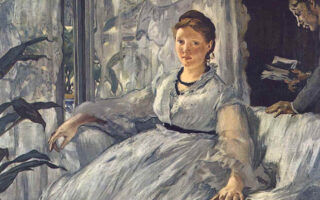Blues
- SUBSCRIBE
- ALREADY SUBSCRIBED?
BECOME A BONJOUR PARIS MEMBER
Gain full access to our collection of over 5,000 articles and bring the City of Light into your life. Just 60 USD per year.
Find out why you should become a member here.
Sign in
Fill in your credentials below.
It’s not supposed to happen, not to me, but it does, and it gets harder to fend off as the days and years go by. Still, it could be worse: my blood doesn’t boil when I see people covered with tattoos who must have seen Rod Steiger in “The Illustrated Man” and took it seriously, thinking a picture stabbed into the skin would open the door to an astounding adventure. Piercings don’t bother me, either, and neither causes queasiness, not any more, anyway. I don’t begin sentences with In my day… or When I was your age…, or maybe I stop just before the words come out of my mouth. I’m all right with the current date, down to the seconds on my e-mail headers, but I find I miss things. Not the good old days, but bits and pieces, this and that, artifacts of some other time, idle trifles of the past tense, and I am blue.
It is a form of nostalgia, a mild case, and a little puzzling. The Greek parts of the original word mean more or less homesickness, but home for me has always been where I am: middle-aged friends who tell me they are going home for Thanksgiving and mean they are going to visit their parents baffle me. Do they live on a park bench, in a hotel, or under a bridge the rest of the time? But I suppose it really has nothing to do with home, not for me, only with times past, their uninvited remembrance.
In my wanderings around Paris in the last few weeks, I have noticed an absence—one of those things that is truly odd because it should be very hard to do, and usually is, but which seem in my case to pop up just a little too often. How can I put it? I’ve suddenly, again, noticed something that’s not there. There are lots of things that are not there any longer, like Les Halles and La Gare de Montparnasse, but this is something different. The loss of a fine building, even an ugly one if it’s a landmark, is something I think all of us swallow, or choke down, digest, and get rid of. It’s obvious. This isn’t. It’s harder.
Paris used to have a decidedly blue cast to it, not because of evocative shadows late in the day or the colors of buildings, which are nearly all shades of tan, or the sky that is no bluer here than anywhere I know and much less blue than the sky above the beaches of the Mediterranean and the Aegean. It was something else, completely ordinary, banal, and commercial.
Years ago, French workman wore les bleus de travail, “work blues,” the standard off-the-shelf work clothes they bought and wore for years. When they were new, they were a middling blue, not bright, but noticeable. With use and time—and I doubt anyone replaced them until they melted away or became so stained they were black—they got lighter from washing, but not so much. If they make them any longer, I’m not seeing them and don’t know who’s wearing them. They came as pants, shirts, jackets, hats, overalls, jumpsuits, and for all I know handkerchiefs, all depending on need. If you walked by a work site, you saw them, just as you did when you opened the door for the plumber or the electrician. Perhaps the worker’s first outfit came along with the certificate to practice the trade—and was at least tangibly a lot more valuable.
But there was more to French blue—right: the color of the shirt in the catalogue is pretty close after all—and it was fascinating to me in my day and when I was your age, if you are a lot younger than I. The same color seemed to be the favorite, the universal champ of men’s couture. I think I could have uncoiled the snail of the twenty Arrondissements on foot and been sure that half the men wearing suits were wearing a blue one, that blue, not navy, not royal. The next day it was the other half’s turn—not the better half’s turn, mind you, because I never saw and still haven’t to this day seen a woman in that color, though the pervenches in their periwinkle outfits as they put tickets on windshields of illegally parked cars, come close, a little, maybe.
That particular blue was obviously a badge of respectability and dignity in the man walking near the Opéra one day who stepped in a pile of the residue of a dog, yelled merde, then stamped his other foot down in the poop. It occurred to me that this was a moment to learn something—after all, is what he stepped in properly merde, or rather étron, bouse, or chiure, if definitely not fiente and probably not crottin? I thought better of it and walked off watching him scraping his shoes on the curb, but with his head held high, not looking down at his violated shoes, rather nice black loafers, low-cut, the kind I have learned to wear since then.
Still, I did manage to step in something a few years later. I was looking at a poster outside a movie house when a man came by and said, Tati est marrant, vraiment désopilant, comme toujours. Okay, I said, thanks: I think Tati is always funny as hell, too. And so we got talking about this and that—and my blue fascination got the better of me. Have you ever noticed, I asked him, that the blue suit that is so popular among businessmen like yourself and evidently the sign of success and respectability, is almost the exact same color as the bleus de travail of the working class? No, he had not, nor did he think my observation on color schemes and sartorial rank was anywhere near the truth. They have nothing in common, not remotely the same. Why, he asked, obviously not finding me in the least désopilant, would a man of means and standing want to resemble an ouvrier? Maybe, I suggested, les ouvriers wanted to resemble men of means and standing? Of course not, never, why would they? The French working man is not like that. And so we said goodbye—I did, and perhaps he did too.
I have often wondered if I started something. Did the man I had evidently and inadvertently insulted—it was he, not his wardrobe that was at issue, as he saw it—think it over, consult with friends, decide to take action, form an association, a committee? Had he and his friends and the tens of thousands of blue-suited Parisians never noticed the similarity because the workies in their bleus were invisible? Did I make them visible? Did I throw the pebble that became the tidal wave, make the gesture with my hand that turned out to be a typhoon? I can’t take so much credit, but I’d be glad to have a footnote somewhere.
Perhaps it was something else, or many somethings, that made the blue suits choose other colors until that shade is not in evidence anywhere I walk these days. Of course that is the simple solution, but not terribly compelling. Perhaps the workmen decided that the better-paid wage-slaves in their suits in the same color as their work clothes were really an emblem of their own servitude and resolved to ditch the work blues for—what else?—blue jeans, without matching shirts and hats, and anyway a completely different color. Two liberation movements, two sartorial revolutions, and the blue of Paris is gone. Too bad. The blue of that era was such a semaphore, a colophon, a jingle of Paris for me, so then of Paris, and still is now. I’m not supposed to think that, I’m supposed to know better, too bad, but I miss it.
Please post your comments and let them flow. Register HERE to do so if you need a user name and password.
© Joseph Lestrange


